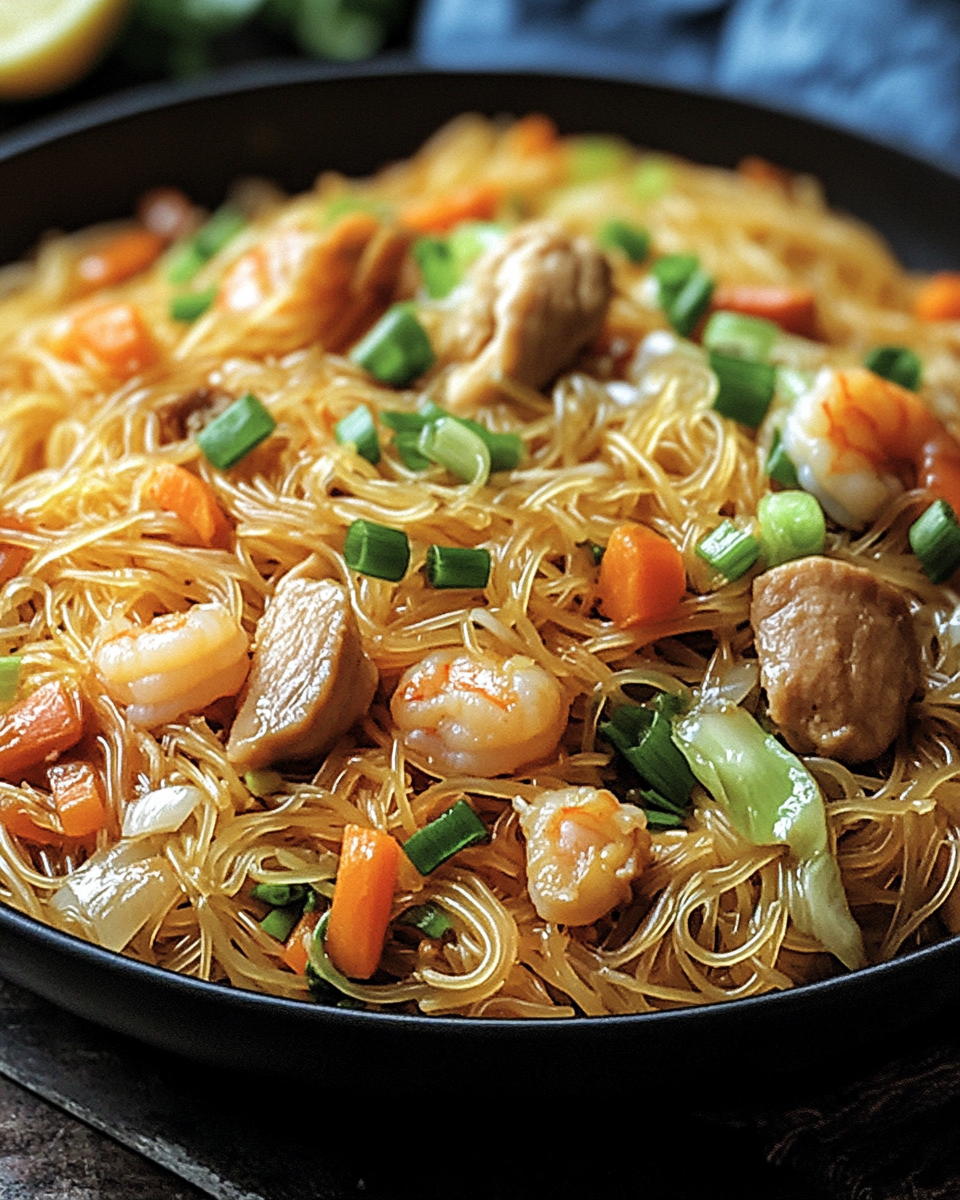This Filipino Pancit recipe is a beloved staple in every Filipino household. Known for its colorful medley of vegetables, tender meat, and springy rice noodles, this dish is often served during birthdays, family reunions, and festive gatherings to symbolize long life and good fortune. What makes Pancit truly special is its ability to bring people together whether served in a large bilao (woven tray) for a party or quickly tossed up for a weeknight dinner. It’s incredibly versatile, easy to prepare, and a joyful introduction to Filipino cuisine. The harmony of textures and flavors crunchy vegetables, savory meats, and delicate noodles makes this a meal to remember.
Full Recipe:
Ingredients:
-
8 oz pancit bihon (rice noodles)
-
2 tbsp vegetable oil
-
3 cloves garlic, minced
-
1 onion, sliced
-
1 cup chicken breast, sliced thinly
-
1 cup shrimp, peeled and deveined
-
2 tbsp soy sauce
-
1 tbsp fish sauce
-
2 cups cabbage, shredded
-
1 cup carrots, julienned
-
1/2 cup green beans, sliced
-
1 1/2 cups chicken broth
-
Salt and pepper to taste
-
Calamansi or lemon wedges, for serving
-
Green onions and fried garlic for garnish
Directions:
-
Soak rice noodles in warm water for 10-15 minutes until softened. Drain and set aside.
-
Heat oil in a large skillet or wok over medium heat. Sauté garlic and onion until aromatic.
-
Add chicken and cook until lightly browned, then add shrimp and cook until pink.
-
Pour in soy sauce and fish sauce. Mix well.
-
Add carrots, green beans, and cabbage. Stir-fry for 2-3 minutes.
-
Pour in the chicken broth and bring to a simmer.
-
Add the soaked noodles. Toss gently to combine with vegetables and meat.
-
Cover and cook for 5 minutes or until noodles have absorbed the liquid and are tender.
-
Adjust seasoning with salt and pepper to taste.
-
Serve hot with calamansi or lemon wedges, garnished with green onions and fried garlic.
Prep Time: 15 minutes | Cooking Time: 20 minutes | Total Time: 35 minutes
Kcal: 345 kcal | Servings: 4 servings
Discovering Filipino Pancit: A Cultural and Culinary Treasure
Filipino Pancit is far more than just a noodle dish it is a culinary expression deeply woven into the cultural, historical, and familial tapestry of the Philippines. Whether it graces birthday celebrations, town fiestas, or simple weeknight dinners, Pancit remains a symbol of Filipino resilience, adaptability, and a zest for flavorful food. Derived from Chinese influences and evolved over centuries to reflect the local palate, this dish has become an iconic staple in nearly every Filipino household.
As the name suggests, “Pancit” is a Filipino term that encompasses a wide range of noodle-based dishes. Among them, Pancit Bihon made with rice vermicelli noodles is one of the most widely known and cherished. With its mix of savory meats, fresh vegetables, and a rich, umami-forward sauce, Pancit Bihon offers a perfect balance of taste, nutrition, and visual appeal. This dish captures the essence of home-cooked Filipino food: simple, comforting, and always meant to be shared.
A Brief History of Pancit in the Philippines
The origin of Pancit dates back to the early Chinese traders who arrived in the Philippines centuries ago. The word “pancit” itself comes from the Hokkien term “pian i sit,” which loosely translates to “something conveniently cooked fast.” Over time, the Filipinos embraced the concept of noodles and made it their own, incorporating local ingredients, spices, and culinary techniques to develop distinct variations such as Pancit Canton, Pancit Malabon, Pancit Luglug, and Pancit Bihon.
Pancit Bihon specifically uses thin rice noodles, which are often stir-fried with a combination of chicken, shrimp, vegetables like carrots and cabbage, and seasoned with soy sauce and fish sauce. What makes this dish uniquely Filipino is its seasoning profile and how it’s lovingly prepared in both everyday settings and festive occasions.
Cultural Significance of Pancit
In the Philippines, food is never just about nourishment it is an act of togetherness. Pancit plays a central role in this philosophy. It is often served at birthday parties because of a popular belief that noodles symbolize long life and good health. Thus, the longer the noodles, the better a practice inspired by Chinese tradition but uniquely adapted in Filipino culture.
Furthermore, Pancit is considered a “sharing dish.” It is usually cooked in large batches and laid out in platters or woven trays called bilao, inviting everyone to dig in together. This sense of communal dining enhances the dish’s appeal, making it more than just food it becomes a social experience.
Versatility in Every Bite
One of the reasons Pancit has remained a household favorite is its versatility. The base ingredients can be adapted to suit whatever is available in the kitchen. Don’t have shrimp? Skip it and double up on chicken or tofu. Running low on vegetables? Any leafy green or seasonal vegetable can make a delightful addition.
In fact, this flexibility has led to regional variations across the Philippines. In Lucban, Quezon, there’s Pancit Habhab, served on banana leaves and eaten without utensils. In Malabon, the local version boasts thick noodles with a seafood-based sauce and is garnished with hard-boiled eggs and smoked fish flakes. These adaptations reflect the ingenuity of Filipino cooks in making the most of what’s available while still maintaining the essence of the dish.
The Joy of Cooking Pancit
Although Pancit looks and tastes elaborate, it’s relatively quick and simple to make, which adds to its popularity. The cooking process emphasizes technique over complexity: sautéing aromatics, layering flavors, and tossing ingredients at the right time ensures that every component from tender meats to crisp vegetables retains its texture and vibrancy.
Because of this balance, Pancit makes an ideal dish for both beginner cooks and seasoned chefs. It’s a one-wok meal that offers nourishment, visual appeal, and deep flavor without requiring extensive culinary training. This accessibility makes Pancit a frequent star at potlucks, office lunches, and everyday family meals.
Pancit in Modern Filipino Cuisine
In recent years, as Filipino cuisine gains global recognition, Pancit has found its way into restaurants, food festivals, and even fusion menus worldwide. Foodies outside the Philippines are discovering this dish as an entry point into Filipino culinary culture.
Creative interpretations are also on the rise. Some chefs are swapping out rice noodles for glass noodles, adding curry flavors, or turning Pancit into spring roll fillings and noodle bowls. While traditionalists might stick to the original recipe, these new takes only emphasize the dish’s universal charm and adaptability.
Nutritional Value and Dietary Options
Another strong point of Pancit is its nutritional profile. Packed with protein from chicken and shrimp, and fiber and vitamins from a variety of vegetables, it offers a well-rounded, balanced meal. The dish is naturally gluten-free if you use rice noodles and tamari in place of soy sauce, making it suitable for people with gluten sensitivities.
Vegetarians and vegans can also enjoy Pancit by replacing animal proteins with tofu, tempeh, or mushrooms, and using plant-based sauces. The fact that it’s easily customizable means it can be tailored to meet various dietary needs without sacrificing taste or tradition.
How to Serve and Enjoy Pancit
Pancit is best enjoyed hot, fresh off the wok, often with a wedge of calamansi or lemon on the side. The citrus adds a bright acidity that lifts the savory notes of the dish. Traditional garnishes like chopped scallions and crunchy fried garlic enhance both the presentation and flavor.
When serving Pancit for guests, presentation matters. A colorful bilao garnished with vibrant vegetables, shrimp, and herbs makes for an eye-catching centerpiece. For everyday meals, a generous bowl of Pancit with steamed rice on the side delivers ultimate comfort.
A Must-Have on Every Filipino Table
Whether you’re an experienced home cook or someone just beginning to explore Asian cuisine, Pancit is a dish worth mastering. Its history, flavor, and flexibility make it a cornerstone of Filipino food culture. Preparing and sharing Pancit is more than just a culinary exercise it’s a celebration of heritage, hospitality, and the universal joy of good food.
This dish connects generations, brings people together, and adapts beautifully to changing times. As you bring Pancit into your home, you’re not just preparing a meal you’re partaking in a tradition that continues to thrive in every Filipino kitchen across the world.
Conclusion:
Filipino Pancit is a dish that speaks volumes about the culture and spirit of the Philippines. It’s hearty yet light, simple yet full of flavor, and traditional yet incredibly adaptable. From festive tables to everyday dinners, Pancit is always welcome.
Whether you’re making it to celebrate a special occasion or just craving something nourishing and delicious, Pancit delivers every time. As you prepare it, take a moment to appreciate the legacy it carries and the stories it continues to tell with every stir, every garnish, and every shared plate.






